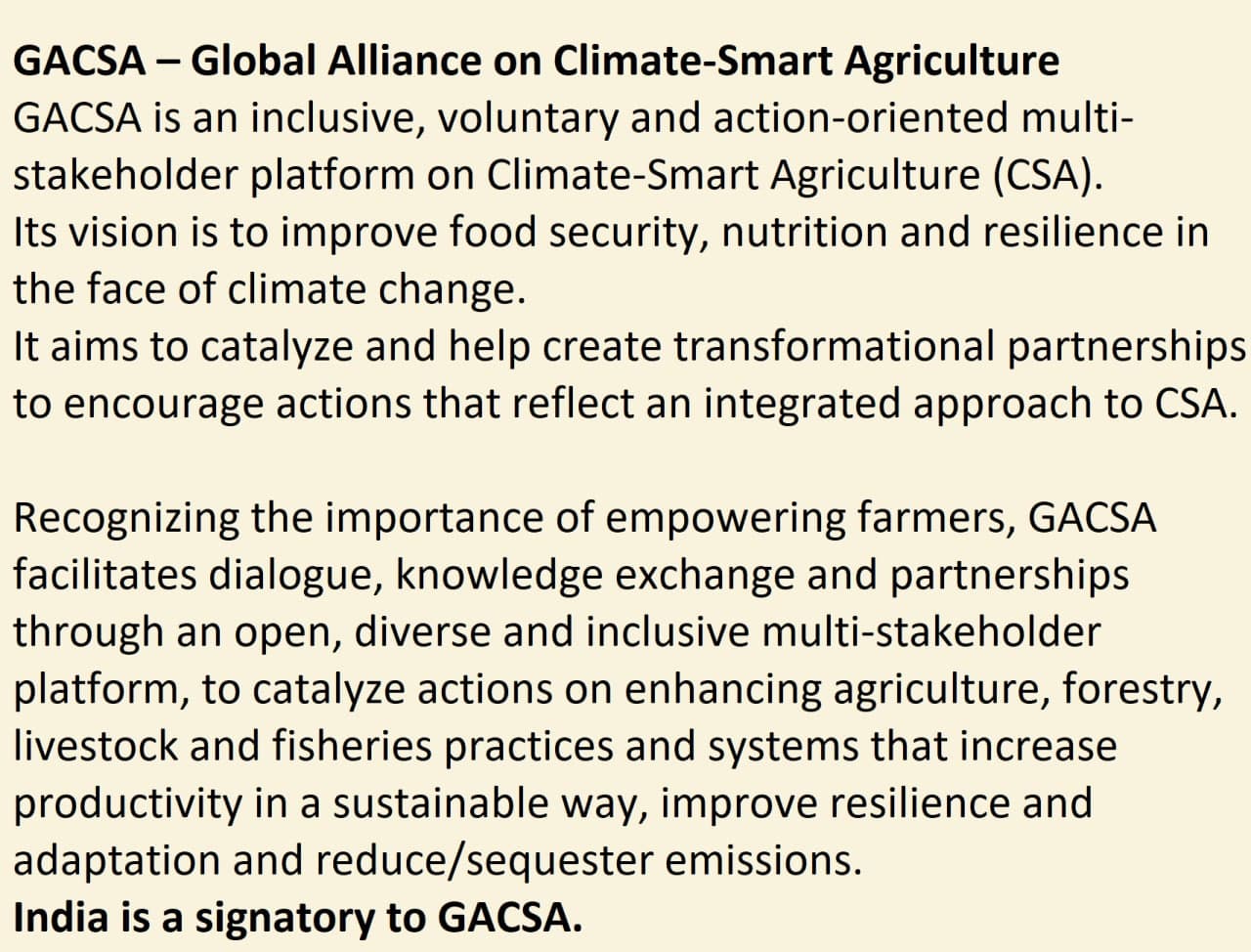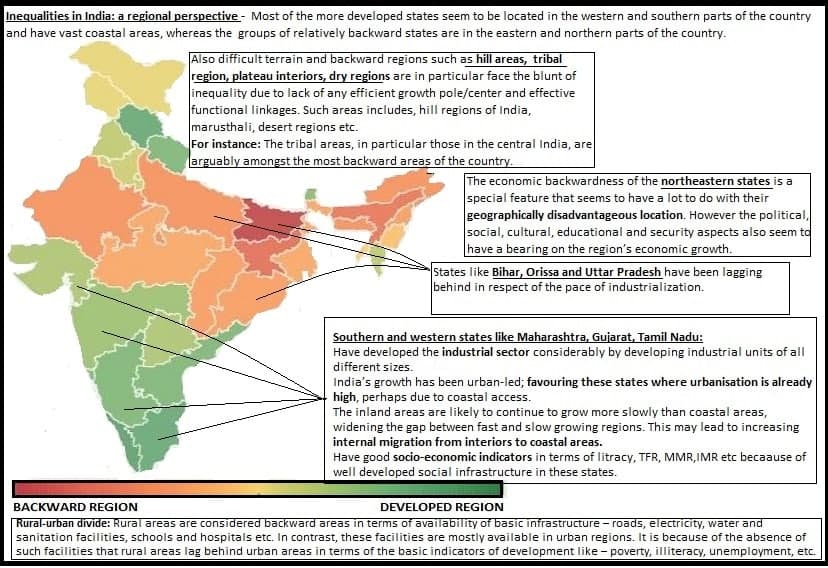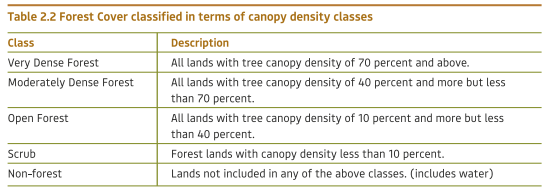19 Feb
Internal migration in India-Reasons & challenges associated with it
In News
A webinar series ‘Thinc Migration’ by the Indian Express recently discussed how COVID induced disruptions impacted internal migrants, especially the migrant women and children.
Overview of Migration
- Migration is the movement of people away from their usual place of residence, across either internal (within country) or international (across countries) borders.
- As per the Census 2011, India had 45.6 crore migrants in 2011 (38% of the population) compared to 31.5 crore migrants in 2001 (31% of the population).
- Between 2001 and 2011, while population grew by 18%, the number of migrants increased by 45%. In 2011, 99% of total migration was internal and immigrants (international migrants) comprised 1%.

Trends and Patterns of Internal migration
- Internal migrant flows can be classified on the basis of origin and destination. This includes: rural-rural, rural-urban, urban-rural and urban-urban.
- As per 2011 census, there were 21 crore rural-rural migrants which formed 54% of classifiable internal migration.
- Rural-urban and urban-urban movement accounted for around 8 crore migrants each. There were around 3 crore urban-rural migrants.
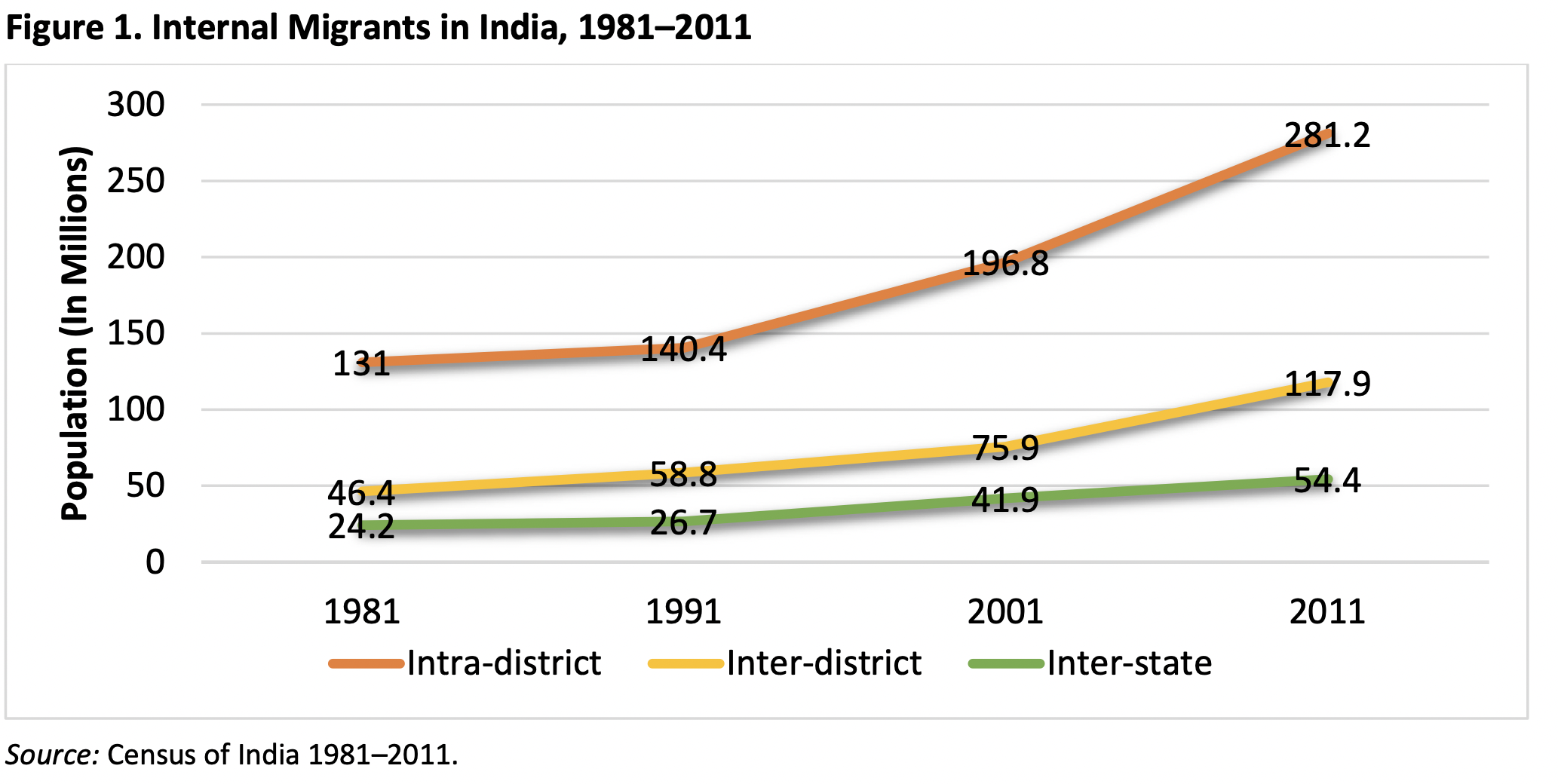
- Another way to classify migration is: (i) intra-state, and (ii) inter-state. In 2011, intra-state movement accounted for almost 88% of all internal migration (39.6 crore persons).
- The Economic Survey (2017) estimated that an average of 5–6 million Indians migrated annually between 2001 and 2011, leading to an inter-state migrant population of “about 60 million” and an inter-district migrant population “as high as 80 million”.
- The net in-migration is mainly found in developed states like Punjab, Haryana, Maharashtra, Gujarat and Delhi where pull factor is stronger. These states attract population from almost all states.
- On the other hand, most of the remaining states are net out-migrating, but not all of them are poor states. The notable example is the state of Kerala and Tamil Nadu that are socially and educationally the most developed states of India. A large population from these two states is also migrating to the Gulf countries.
- During the two decades, the number of people migrating from the states of Bihar, Uttar Pradesh, West Bengal, Orissa, Jharkhand and Assam to Kerala and Tamil Nadu has increased steadily due to high labour requirements in agriculture, manufacturing sector, construction industry and service sectors.
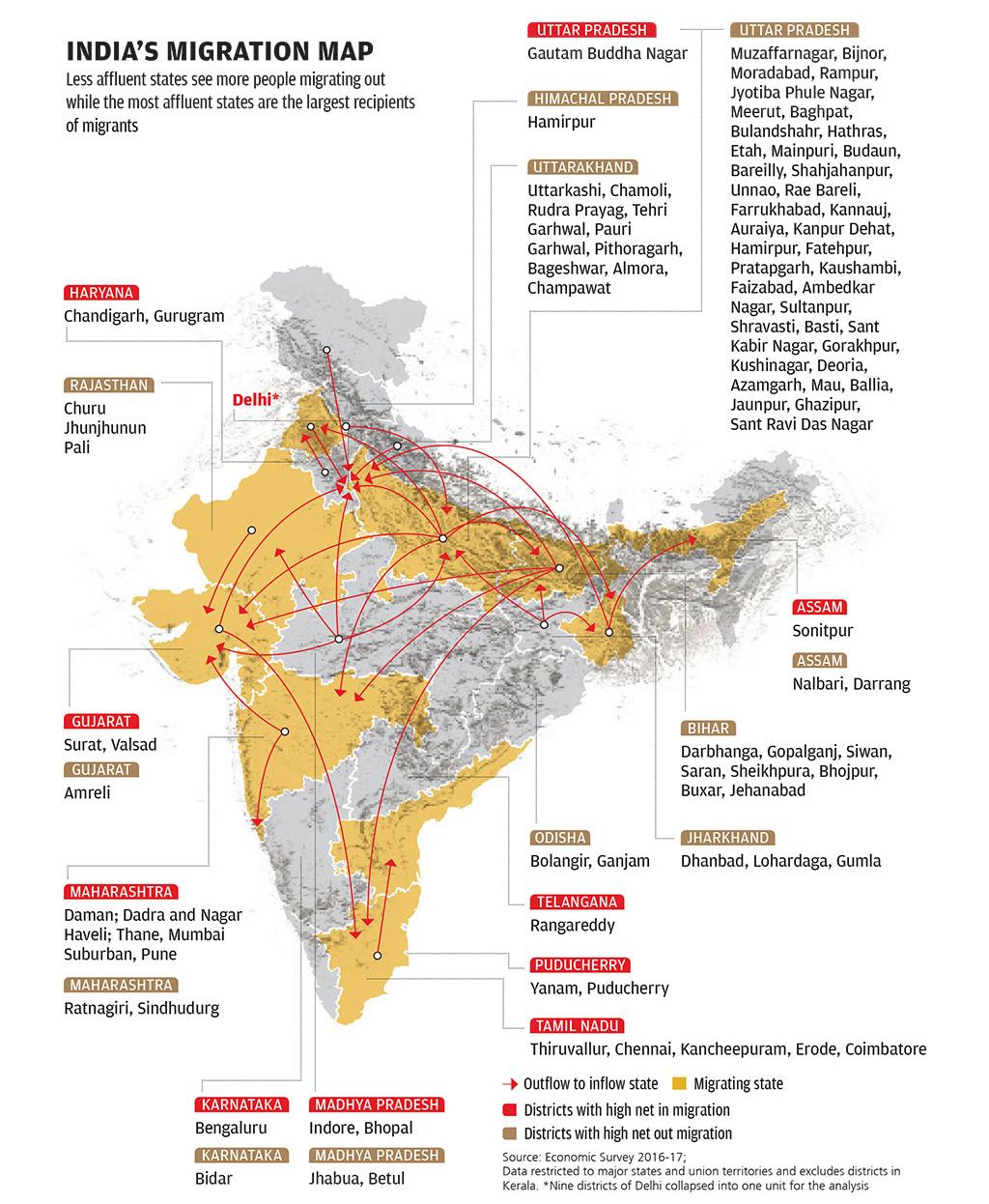
Reasons for Internal Migration
- Strong Push Factors: Migration and regional disparities are strongly interlinked. Lee’s theory (1965) of volume of migration states that the “volume of migration within a given territory varies with the degree of diversity of areas included in that territory”.
- Economic Criteria is the basic motive behind most of the migration. In a study on “Inter-state migration and regional disparities in India” found that in India, even in recent times, inter-state migration of the males for employment, (as well as of females) is still very much linked with the underdevelopment, poverty, spatial disorganization, regional disparities, social inequalities, rural stagnation, rural neglect and unbalanced regional development over national space.
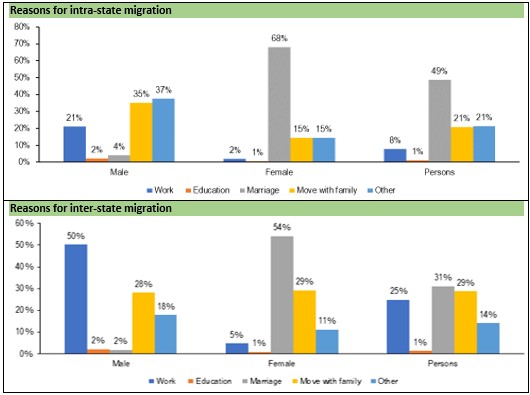
Challenges of Internal Migration
- Forced Displacement: A large number of people are forcefully displaced due to mega-dams, Special Economic Zones, corporate land grabs for mining and industrialization. Of the 60 million displaced people because of mega projects, between 1947 and 2000, as many as 10-20 million tribals have been displaced by ‘development’ projects.
- People migrating for work face key challenges including: i) lack of social security and health benefits and poor implementation of minimum safety standards law, ii) lack of portability of state-provided benefits especially food provided through the public distribution system (PDS) and iii) lack of access to affordable housing and basic amenities in urban areas.
- These challenges were quite evident during the covid lockdown in 2020 when a huge migrant wave started and government faced difficulties in providing the migrants necessary health and social security.
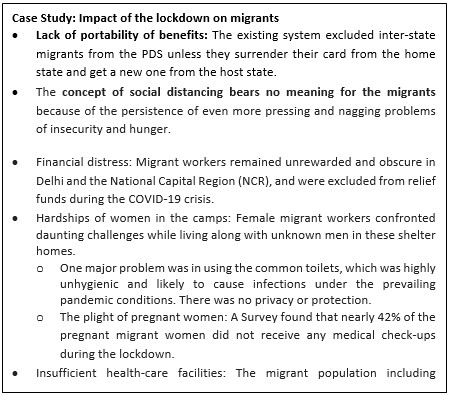
- Xenophobia: The anti-lungiwalas movement of the 1960s, anti-bhaiya movement of 1980s in Maharashtra, ‘sons of the soil’ movement in Assam, similar such anti-migrants agitations and attacks in Gujarat, Karnataka, etc., are only examples of the xenophobic tendencies. Today this xenophobia is alarmingly increasing. There are several reported cases where north Indian migrant workers were beaten up, lynched and killed based on suspicion and rumors.
- Language, food and other cultural barriers: Most of the migrants who come from rural areas of North India speak only their mother tongue and cannot converse sufficiently well in other regional language of Western and Southern India. Neither the local people in South India are conversant in Hindi. Hence, communication with local people and employers, travelling, accessing government benefits, medical facilities, reading and writing and integration with the local culture and food habits are major challenges for migrants.
- Lack of affordable housing and basic amenities in urban areas: The proportion of migrants in urban population is 47%. In 2015, the Ministry of Housing and Urban Affairs identified migrants in urban areas as the largest population needing housing in cities. There is inadequate supply of low-income ownership and rental housing options. This leads to the spread of informal settlements and slums.
- Exploitation, discrimination and non-payment of wage: The vulnerability of the migrants is vivid, especially when it comes to working hours, safety measures, hazardous jobs and low wages compared to the local workers.
- Sexual abuse and gender violence: Women migrants are the most vulnerable. Women face double victimisation: their wages are lower than that of men, and they are sexually abused and harassed. For example, 80% of Bangalore’s garment factory workers are women, and these women undergo high levels of sexual harassment and violence at the workplace.
- Most of these women garment workers are young, unmarried and are from SCs and STs. Many of them are from Odisha, Jharkhand and West Bengal. The study found that one out of every 14 women garment workers experienced physical violence, and 14% complained of rape and sexual abuse.
- Trafficking and bonded labour: Migrant workers are susceptible to human trafficking and become bonded labourers. According to a report of the Bonded Labourers Review in the State of Karnataka, a total of 7,646 people are allegedly forced to work as bonded labourers in different districts of Karnataka. 333 bonded labourers including children were rescued from Tamil Nadu brick kilns in 2015.
- Health hazards, accidents and deaths: Migrant workers are vulnerable to health hazards and infectious diseases due to deplorable living conditions often provided by the employer at the work sites.
- Migration brings in a loss of human capital in the villages, and it adversely affects the local environmental sustainability. The flow of financial remittances by the migrants back in their places of origin can have both positive and negative effects for conservation and the protection of the environment and biodiversity.
- Looking from the perspective of migrants, one can recognise that they are rarely seen as full citizens in their places of work. They lose their voting rights, no possibility of identity (e.g., tribals are not recognised as tribals in some states), no free health care, no subsidised food and no fuel under the Public Distribution System (PDS). They cannot access free education for their children. Often regarded as illegal residents, they are subjected to harassment from both the administration and the police.
- Social Composition of Migrants: Mostly deprived migrants include SCs, STs, Women and Children.
- Challenges of Reverse Migration: This relates with loss of skilled human resource at destination places, oversupply of labour at native place, unemployment, social tensions etc. This was quite evident during the covid lockdown.

Conclusion: The magnitude and variety of internal migration flows in India, as well as the distresses associated with them, are enormous. A basic overview of this complex phenomenon makes clear that in spite of the vast contributions of migrants to India’s economy, the social protections available to them still remain sparse.
While the state and market have failed in providing protections to these millions of internal migrants, civil-society interventions across various high migration pockets in India offer a number of successful, context-specific solutions that the government can adapt and build upon in order to protect this marginalized segment of workers. A concerted national strategy that ensures access to entitlements and basic work conditions will be essential in building a sustainable and equitable pathway to progress.
Sources:
- Migration in India and the impact of the lockdown on migrants
- Internal Migration in India: Integrating Migration with Development and Urbanization Policies
- Internal Flows and the Challenges in Indian Subcontinent
- Internal Migration Scoping Paper
- Internal Migration in India Grows, But Inter-State Movements Remain Low
- Inter-state migration and regional disparities in India
- Explainspeaking: What 2020 taught us about India’s internal migration
- Ideas of India: Internal Migration for Aspiration vs. Compulsion
- A million migrations: Journeys in search of jobs
- The plight of migrants during COVID-19 and the impact of circular migration in India: a systematic review
- MIGRATION AND URBAN HABITAT
- India’s brutally uneven development patterns are mapped in routes migrant workers are taking home
- Explained: Indian migrants, across India
- Social inclusion of internal migrants in India
Unusual Weather and Severe Cold Events in North America
In news
A historic winter storm Landon has brought record snow and damaging freezing rain in parts of the U.S., Canada and North Atlantic.
Conditions that fuel severe winters in North America
- The main driving factor behind the cold outbreaks is the Polar Vortex. It is an important part in the stratosphere that drives the dynamic weather patterns.
- Compared to recent years, the Winter Season 2021-22 has a very strong and active Polar Vortex aloft.
- Many of the Arctic cold outbreaks and winter storms developing in Canada, the USA, Asia, or Europe, are triggered by it.
- The storm started when the polar vortex bulged down over the Texas panhandle, carrying in ultra-cold, low-pressure air from the northern Great Plains.
- The similar phenomenon was responsible for big freeze in the year 2021 as well. But unlike that storm, which stalled over Texas after a blockage in the jet stream, this one is fast-moving, driven by temperature contrasts between the Southeast and Midwest.
- This factor sets it apart from several recent disasters, like the floods in Germany and the heat domes in the Pacific Northwest last summer, that have been the result of buildups in the jet stream.
- Such changes in the jet stream and other extreme weather have been linked to climate change, although the connection is still subject to debate.
- With Winter Storm Landon, the cold, dry air moving south sucked warm, wet air from the Gulf of Mexico inland. Where the two air masses met, in a band stretching from Dallas to Maine, much of that moisture fell as snow, sleet, or rain.

The Developing of Bomb Cyclone in North Atlantic
- In general, during winters, powerful intrusions of the very cold, Arctic air masses lead to the development of deep cyclones over the warmer Atlantic.
- Polar Vortex, which was particularly strong in the Winter Season 2021-22, drags very cold, often frigid cold, Arctic air mass across the North American continent into the Northwest Atlantic.
- Powerful intrusions of the very cold, Arctic air masses lead to the development of deep cyclones over the warmer Atlantic. This results in an explosive Atlantic storm, classified as bomb cyclone.
- A bomb storm develops when explosive cyclogenesis with the extremely rapid deepening of its barometric pressure occurs. This is known as the bombogenesis process.
- Technically, for a cyclonic system to be officially classified as a bomb cyclone, the pressure should fall at least 24 millibars within 24 hours. A typical Nor’Easter along the US coast is an example of such bomb cyclones.
- Like the classic extratropical cyclone, bombs are fueled by temperature variations, between the warmer temperatures over the Atlantic coming from the Equator and much cooler temperatures towards the Arctic region. This also occurs vertically throughout the atmosphere.
- Statistically, there are about 60-70 such cyclone-type formations on Earth every year. About two-thirds of them occur in the Northern Hemisphere.
- Typically, the east coasts of the North American continent and Northwest Atlantic Ocean are perfect breeding grounds for these types of cyclones during the late autumn/fall and winter
- There, an interaction of the Arctic cold continental air mass and warm moist ocean tropical air mass provides a lot of energy for cyclonic systems to rapidly develop. They often literally explode over the Atlantic.
- The other bomb cyclones are found in the northwestern Pacific around Japan. Even Australia can get several of them each year, although they rarely have so rapid intensification as the Atlantic or Pacific storms.

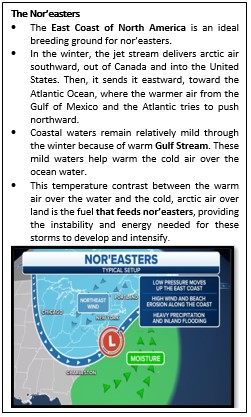
Conclusion: Cold waves are becoming more infrequent because of climate change and there has been a decline in new cold temperature records as a result of global warming. In its Fifth Assessment Report, the Intergovernmental Panel on Climate Change stated that there will be more frequent hot and fewer cold temperature extremes over most land areas on daily and seasonal timescales as global mean temperatures increase. Thus, it is very likely that heat waves will occur with a higher frequency and duration. But occasional cold winter extremes will continue to occur.
Where can we use it-
Geography Optional
P1: Climatology (Climate change) , Environmental Geo and Biogeography.
P2: Contemporary.
GS: GS3 (Environment).
Sources:
- After a Record Winter Storm Landon in North America, the Polar Vortex now drags the same system towards Iceland, becoming the Most Intense Bomb Cyclone of the year next Monday
- Ice, tornadoes, and cracking trees: Why Winter Storm Landon dragged a melee of weather across the US:
- Winter Storms:
- What makes a storm a nor’easter?:
Unusual and Prolonged Winters of 2021-22 in India
In News
The winter of 2021-22 is appearing to be unusually cold and unusually long, especially in North India. The days, in particular, have felt colder and chillier than normal.
Early winter arrival
- Winter had set in early in India after a long-drawn monsoon, which ended October 26, 2021. The first evidence of this came from Jammu and Kashmir and Ladakh, both of which received early snowfall around October 11, 2021 and intermittently ever since.
- The higher reaches of Uttarakhand and Himachal Pradesh also received snowfall in the last days of October. Though not uncommon but its intensity this time was higher for the period.
- The immediate reason for the early onset of winter and the rainfall in the North and Northwest was the interaction between an active western disturbance over Afghanistan and moisture laden easterly winds flowing in from the Bay of Bengal.
- A western disturbance (WD) is an extra tropical storm that travels to India from the Mediterranean Sea and brings moisture and winds along with it. The event causes most of the winter rainfall and snowfall over north and northwest India.
- According to climate scientists, the Mediterranean Sea is warmer than normal this season. This would mean that the WDs travelling from there may carry more moisture than usual and subsequently, be more intense.
During winters (November 2021-February 2022)
- Cold Days
- Since December 2021, maximum temperatures across the North, Northwest and Central India regions have persistently remained below normal, resulting in “cold day” conditions.
- This winter, Delhi witnessed eight cold days in January (until January 25), with the lowest maximum temperature recorded at 12.2 degrees Celsius on January 25.
- Many places in Maharashtra have experienced “cold day” conditions as Maximum temperatures at several places in Madhya Maharashtra and Konkan, including Mahabaleshwar, Pune, Mumbai, and Nashik have been 6 to 8 degrees Celsius below normal in January.
- “Cold days” often mean warmer nights. “Persistent clouding blocks out the rays of the Sun and heating during the day, but keeps the nights warmer than normal.”
- Cold Wave Conditions: Cold wave to severe cold wave conditions continued throughout winters.
- According to the National Disaster Management Authority (NDMA), “Cold wave is distinguished by a well-defined and protracted period of lower temperatures" and is an extreme weather phenomenon that prominently occurs between the months of November and February.
- Cold waves are linked to "transient disturbances in the mid-latitude westerlies" in the northern sections of India, particularly the hilly regions and adjacent plains.
- This has also been a rather wet winter
- The January 2022 has seen widespread rain across the central, northwestern, northern, eastern, and northeastern regions of India.
- As many as 24 states or Union Territories have recorded rainfall varying from excess to large excess this month. The only exceptions have been Arunachal Pradesh (minus 26%), Mizoram (minus 43%), Goa (minus 44%), Karnataka (minus 80%), Kerala (minus 76%) and Lakshadweep (minus 99%).
- January has been significantly wet over Delhi, Odisha, Madhya Pradesh, Uttar Pradesh, Uttarakhand, Haryana, Punjab, Chhattisgarh, Himachal Pradesh, Jammu and Kashmir, Ladakh, and Rajasthan, taking the all-India rainfall nearly 200% above normal.
- Delhi witnessed the wettest January in 122 years. Other states and Union Territories with large surpluses of rainfall during this month include Uttarakhand, Chandigarh, Himachal Pradesh, Jammu and Kashmir, and Punjab.
- The winter has been less foggy than normal. December and January are known for the formation of dense fog across North India.
- Compared to the average 278 hours of fog — during which visibility falls below 1,000 metres — over 26 days, Delhi saw only 75 hours of fog spread over 22 days in December 2021. This was the lowest for December since 1982. In January too, Delhi recorded the lowest fog duration since 2008.
- IMD officials said the ongoing winter has recorded the lowest fog hours since 1991-92 over Delhi. Strong northern and north-westerly winds have been dominant since mid of December 2021.
- This winter saw an unusual duststorm reaching parts of Gujarat, Maharashtra, and Delhi over the third weekend of January. The strong winds associated with the duststorm originated above Saudi Arabia and picked up local dust along its course from the desert regions of Afghanistan and Pakistan.
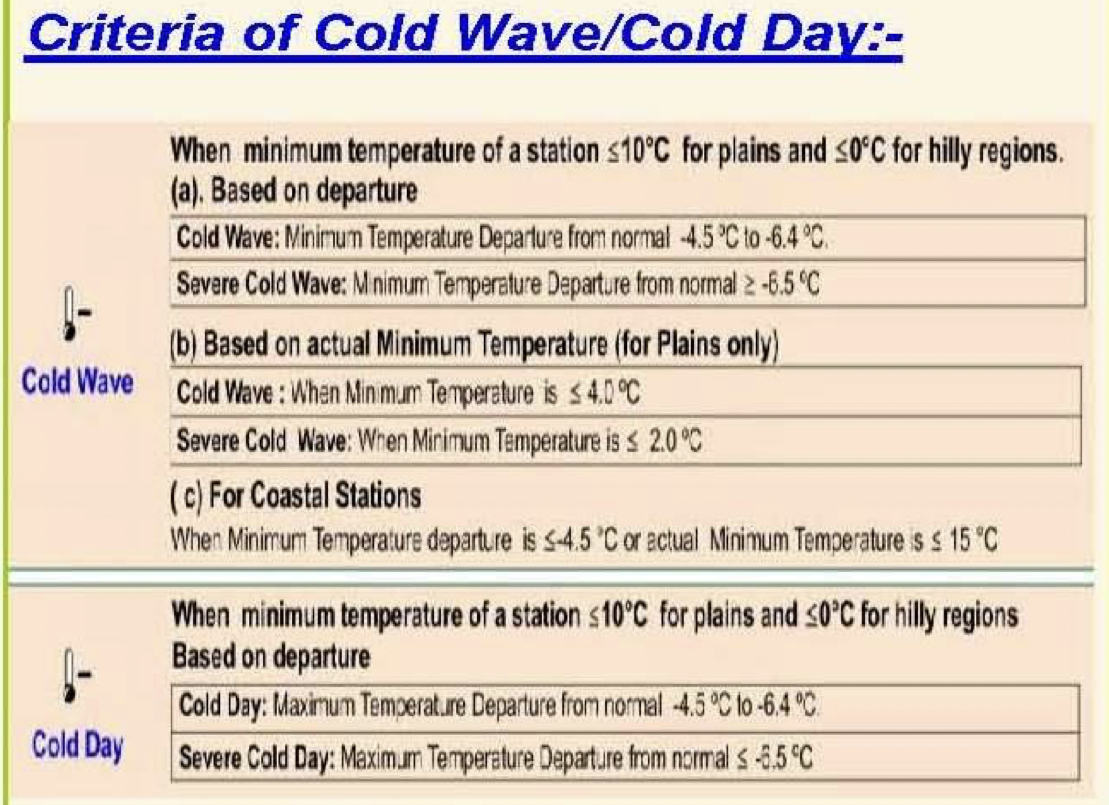

Reasons for unusually cold and prolonged winters
- Western disturbances: Winters over India are directly affected by the intensity and frequency of western disturbances —
- Until January 25, seven western disturbances had passed over India — nearly all of them strong enough to cause widespread rain, snowfall, and squally weather across large geographical areas between Pakistan and Northeast India.
- These systems caused hailstorms in northern Maharashtra, and heavy rainfall in Tamil Nadu.
- La Nina: Frequent and higher numbers of western disturbances are associated with La Niña. At present, moderate intensity La Niña conditions — which manifests itself as cooler than normal sea surface temperatures in the equatorial Pacific Ocean — are prevailing.
- Cold Winds from North: After a western disturbance crosses India, cold winds from the far north of the country penetrate to lower latitudes, and can reach up to even Telangana and Maharashtra, leading to colder weather, and sometimes to cold wave conditions.
- Clouds Cover: The presence of low-lying clouds and the availability of moisture along the Indo-Gangetic plains made it favorable for cold day conditions and the additional chill factor experienced during the day. This was the longest and most intense spell of the season so far.
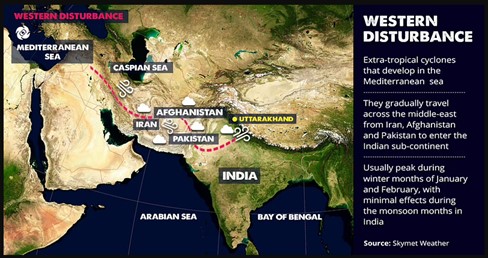
Possible consequences of prolonged cold
- A cooler-than-normal winter and spring can mean there may not be enough warming of the Indian subcontinent, which is crucial for the onset of the southwest monsoon season next year.
- According to a research paper published in the journal Environment Research Letters2018,
- A winter with a La Nina event reduced rainfall during the subsequent southwest monsoon season by 4%. If the winter La Nina event is followed by an El Nino event, the rainfall may go down by up to 15%.
- This would mostly affect the western and southern parts of the country.
- La Nina and a cooler-than-normal and extended winter could also lead to a short, intense summer and heat waves all across India before the monsoon sets in.
Sources:
- This winter has been colder, wetter, and largely fogless. Here is why
- India May See Coldest Winters In Coming Jan-Feb Due To La Nina: Here's How To Cope With It
- What La Nina is and why India should brace itself for a harsh winter
- Wondering why it’s so cold this year? Here’s the tea
- 'A Clear Sign of Climate Change': Experts Explain India's Cold Wave
- Why is northern India shivering? Rains & more cloudy days predicted ahead
- Explained: What Is Causing Severe Cold Wave in North India
- Wet winter, harsh summer, weird monsoon: What La Nina has in store for India in 2022
Abyssal plain
- Abyssal plains are underwater planes on deep ocean floor usually found at the depth of 3000 to 6000 metres.
- These are virtually flat with a gradient approximately 0.05 degrees.
- These are formed due to the levelling caused by deposition of sediments from turbidity currents and pelagic sediments over the sea floor.
- The development of these plains is limited by oceanic trenches. Therefore, the size of abyssal plains is smaller around Pacific Ocean on the other hand the size of these plains is quite large around antarctica.
- These plains are rich in minerals and biotic resources (mostly organism which are not dependent on oxygen enriched water like deep sea coral). Polymetallic nodules (PMN) are quite common in these plains. Some of the exciting features found on epistle planes are hydrothermal vents and cold seep.
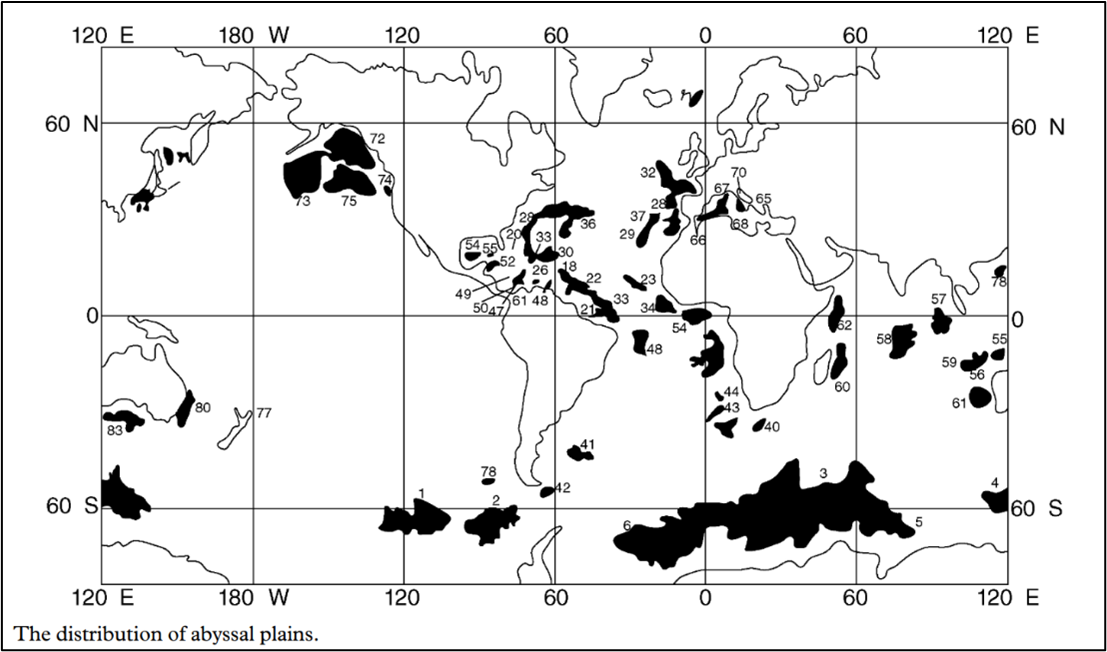
Source:
Climax vegetation
- Vegetation Community exists in a state of equilibrium with certain climatic and edaphic conditions and is self-sustaining.
- This concept was first proposed by an American biologist E. Clements in 1916.
- According to him the ecological Succession continues after colonization of a new surface (such as a lava flow or bare sand dune), until the community reaches a final stage in which it is in harmony with prevailing environmental circumstances.
- As climate is the dominant ecological determinant for the end product of succession, the ultimate product of succession was called the climatic climax community. For example, deciduous forest in cold temperate temperatures of northwest Europe and eastern North America.
- The climax community have more species diversity than earlier successional stages (seral stages) thus, is more stable.
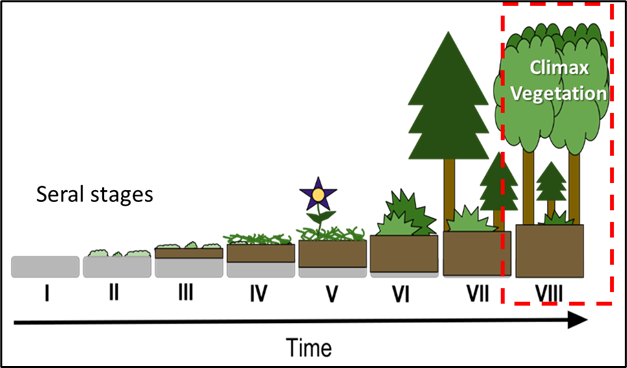
Source:
Frozen fronts
- It is the boundary between frozen or partially frozen ground and non-frozen ground.
- It is formed because the temperature gradually increases as we go down the surface. The water cannot be in frozen state throughout the depth. Thus, the depth at which the temperature goes beyond the freezing point forms the freezing front.
- During freezing in permafrost regions, the freezing fronts move downwards from the ground surface and upwards from the permafrost table. Only a downward moving freezing front exists in seasonally frozen ground.
- The freezing front is sometimes equated with the cryofront, the position of the 0 °C isotherm in the subsurface, forming the boundary between cryotic (i.e., temperature 0 °C) ground. The permafrost base, the permafrost table, and the top and base of the cryotic portion of the active layer all constitute cryofronts or freezing fronts.

Sources:
Decentralized Solid Waste Management - Cradle to Grave Model
Context
- Mysuru city is situated in the Chamundi Hills. Also known as the City of Palaces, it is a popular tourist destination.
- Mysuru City Corporation has implemented decentralised waste management to manage biodegradable waste, a major fraction of municipal solid waste.
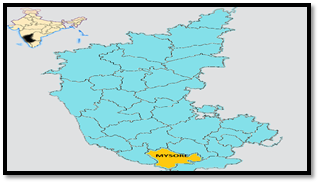
Need for Decentralized Solid Waste Management (SWM)
- The city generates more than 500 tonnes of waste per day. But only 150 to 200 tonnes of waste is being processed per day.
- The most challenging part is management of biodegradable waste. Typically, municipal solid waste comprises approximately 40–60 per cent biodegradable waste.
- The growing height of the dumpsite, its odour and environmental impact demanded a sustainable solution to the Mysuru’s waste.
- Hence Mysuru administration adopted decentralised waste management and the cradle-to-grave model to ensure scientific disposal of biodegradable waste.

Implementation of biodegradable waste management involves four key steps
- Source segregation: Segregated biodegradable waste from households is sent to the zero-waste management plant at the zone level.
- Processing of biodegradable waste: At the zero-waste plant, biodegradable waste is processed by aerobic composting.
- Decentralised zero-waste management units: It was initiated to maximise processing efficiency and minimise load on the centralised compost unit.
- IEC activities: To promote composting and community engagement, campaigns, dramas and seminars are organized at high-footfall areas such as vegetable markets.

Impact and sustainability
- Diverting major quantity of waste reaching open dump, reduces waste sent to landfill.
- Managing the biodegradable waste reduces the long-term effects of global warming, climate change and groundwater pollution (due to seepage of leachate into groundwater.)
- Employment and empowerment: The manual work engages more women workers, safaimitras and self-help groups/porkarmikas and helps them achieve dignified lives by training and authorising them with identity cards.
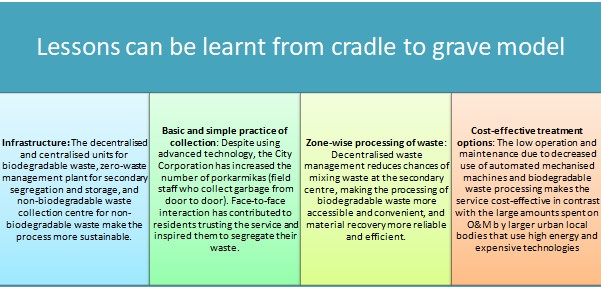
Links:
Places in news
|
Tamenglong
|
|
Kaliveli Lake
|
|
Sambalpur
|
|
Dawan River (or Daman Ganga River)
|
|
Pench tiger reserve (PTR)
|
|
Sela Pass
|

Share the article
Get Latest Updates on Offers, Event dates, and free Mentorship sessions.

Get in touch with our Expert Academic Counsellors 👋
FAQs
Geography Current Affairs focuses on the contemporary issues, events, and developments in the field of geography. It covers recent geographical phenomena, environmental changes, geopolitical shifts, and related news. This differs from regular geography studies which may focus more on foundational concepts, historical contexts, and theoretical frameworks.
Updates are provided regularly to ensure that subscribers stay informed about the latest developments in geography. Typically, updates are provided on a fortnightly basis, depending on the frequency of significant events and changes in the field.
Absolutely. Geography Current Affairs serves as a valuable resource not only for Geography optional but also for GS papers, especially GS Paper 1 (covering Indian Heritage and Culture, History, and Geography of the World and Society) and GS Paper 3 (covering Technology, Economic Development, Biodiversity, Environment, Security, and Disaster Management). It aids in building a holistic understanding of various topics and strengthens answer-writing skills by incorporating contemporary examples and perspectives.
Geography Current Affairs holds immense importance for UPSC preparation, particularly for aspirants opting for Geography optional. It helps candidates stay updated with the latest developments, geographical phenomena, environmental issues, and geopolitical shifts worldwide, aligning them with the dynamic nature of the subject as tested in the UPSC examinations.


